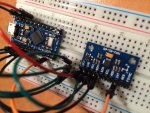I was very impressed with the head tracking implications of this as I've tried (and failed) to get a IR tracker working with my existing webcam. Ordered a cheapish set of kit from china via ebay. Everything looked good when i got it, however I think I've got a physical problem with the hardware and since this is my first breadboard adventure i'm wondering if i can get some help.
The problem I am having is that while I can flash the Ardunio (GUI WORKS PERFECTLY UP TO FLASHING COMPLETE), it doesn't seem to be connecting to the MPU. The startup sequence when power is added is I get a solid red light and ONE flicker of a yellow light on the Ardunio itself, and NOTHING happens on the MPU board. No light at all.
This leads me to fear that it's a jumper issue or a problem with my breadboard technique, again total noob.
I used the pin advice from the ED Tracker website, as follows
All GND (3x on Ardunio and 1x on the MPU to a single row)
VCC >> VCC
Pins 2 & 3 >>> SCL & SDA
Pin 7 >>> Init
No button wiring so all others omitted. Total of 7 wire jumpers placed.
I opted to try to do this solderless, so the header pins are pinning the chips onto the breadboard but are not soldered to the breadboard.
Questions: 1) Will my lack of soldering be a problem? 2) Does my attached pictures indicate any obvious gaffes? 3) Is there any way to get a response from the MPU 9255 using a ohm meter or other


power source etc to see if it actually is functional and not dead? 4) Is it possible to kill this hardware accidentally with a USB cable worth of power to its naughty bits? This is my first project with Arduino and so far it's been a learning experience.



